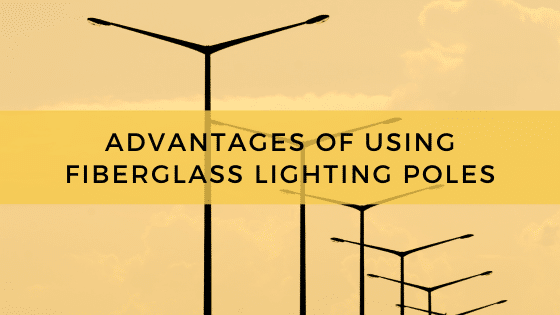
Commercial lighting projects rely heavily on lighting poles to position the fixtures and ensure adequate light distribution. If a new commercial lighting project necessitates poles, you will have three primary choices in pole material – aluminum, steel or fiberglass.
The right material for your lighting poles will depend on the application and exact installation location. For many projects, fiberglass proves to be the best choice.
Three Advantages of Fiberglass in Lighting Poles
Fiberglass consists of a resin and glass fiber mix, offering an ideal combination of strength and flexibility, and here are three advantages of fiberglass lighting poles:
- Durability and wind resistance – Fiberglass offers the best of the material characteristics of both resin and glass. Specifically, fiberglass can flex like resin while retaining the structural integrity of stiffened glass fibers. In effect, fiberglass poles offer excellent all-around durability that makes it a good fit in any application. This includes applications where large amounts of salt are suspended in the air – coastal regions, mainly. Fiberglass is inherently corrosion resistant and fiberglass lighting poles are finished with a protective coating that adds another level of durability. In this way, fiberglass is similar to aluminum in corrosion resistance.The modulus and flexural properties of fiberglass are somewhat akin to bamboo’s, which allows the material to give a little when subjected to high winds. Because this is plastic deformation, the fiberglass bends but does not break, returning to its original shape once the winds have stopped. Along coastal areas where winds can reach hurricane force, fiberglass poles are an effective counter to the extreme conditions.
With its excellent mix of impact, corrosion, and wind resistance, fiberglass requires minimal maintenance. It is standard practice to install these poles and expect 20 or so years of reliable performance before extensive maintenance or replacement is required.
- Lightweight – Fiberglass is significantly lighter than steel or aluminum, while retaining an excellent weight-to-strength ratio. Its reduced weight means fiberglass is easier to handle and easier to install. With fewer equipment and labor resources needed to install fiberglass lighting poles, they are the least expensive option to install.
- Insulated material – Fiberglass is an electrical insulator, unlike metal. In fact, it is used as a material in electrical isolators due to this property. In fiberglass lighting poles, insulator qualities make it a safer choice around electrical components, as it can reduce the likelihood of an unregulated electrical discharge.
If your lighting application demands maximum durability and cost efficiency, fiberglass is a frontline option.
The Different Types of Fiberglass Lighting Poles
Fiberglass poles are available in a full selection of designs and builds, appropriate for any lighting application. They include round and square poles, as well as tapered and straight light poles.
Since fiberglass lighting poles weigh less than metal poles, they can often be installed without an anchor base. An anchor base can be installed if desired, which can provide additional impact resistance and pole heights, but it is not necessary. In applications where direct burial is appropriate, fiberglass can save property owners a lot of money in installation costs.
The light weight of fiberglass is also an advantage in security lighting applications, as it can handle considerable weight. This means that there is plenty of room for surveillance cameras and motion sensors, so property owners have additional options when installing fiberglass poles for security lighting applications.
Pair Fiberglass Lighting Poles with Photometric Analysis for Optimal Results
Fiberglass lighting poles are a viable material option in the majority of applications. To extract maximum value from your new lighting solution, it is highly recommended for businesses to seek out photometric analysis first.
During photometric analysis, the lighting team diagrams the client’s project, going as far as developing a 3D model of the property. This is all done in specialized software.
Once the client’s space is modeled, various lighting fixtures can be placed inside the model and simulated using the fixture’s real-world technical specifications. These specifications are provided by manufacturers, so it is as close as you can get to seeing how the lights will look in action.
Part of this essential analysis is determining pole height. Fiberglass poles can be installed to nearly any height, so it is the application and setting that make the determination. Whether it is a pickleball court, a parking lot, an industrial complex, a beachfront boardwalk, or another application, photometric analysis will identify the most cost effective and best performing fiberglass pole arrangement.
Fiberglass Lighting Poles are a Proven and Effective Option
With the superior combination of durability, corrosion resistance, wind resistance, low weight nature and cost effectiveness, fiberglass lighting poles are a favored choice in all types of commercial lighting projects. No matter the scale or location of your project, chances are, fiberglass poles will provide the most cost-effective lighting solution.






